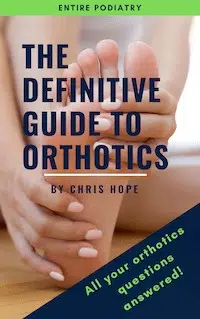What causes Shin Splints?
Generally, Shin Splints are a result of overstraining the muscles around your shinbone, causing the connective muscle tissue to become inflamed and painful. However there are many reasons as to why this tissue is becoming overstrained and inflamed.
Over-pronation (or excessive rolling in) of the foot is a common cause of shin splints, which is why people with flat feet are particularly prone to developing shin splints. Over-pronation causes the tibia to twist and the muscles in the lower leg to overstretch, which can result in inflammation of the soft tissues that attach to the tibia, at the origin of several leg muscles. Poor functioning of the muscles that act to dorsiflex the ankle is also a factor that can cause shin splints.
Other factors that can contribute to the development of shin splints include:
- Tightness in the calf muscles (this can cause further pronation)
- Muscle weakness, particularly of the tibialis anterior and tibialis posterior muscles
- Increasing intensity and duration of activity too quickly (beginner runners are particularly prone to shin splints)
- Improper or ‘worn-out’ footwear
- Running on inclines, uneven terrain or hard surfaces
Causes can generally be placed into two different categories;
- Overuse arising from poor biomechanics (the way that your legs and feet work)
- Overuse arising from incorrect training technique (e.g. increasing training too quickly).
Biomechanical causes
Your ‘biomechanics’ may predispose you to Shin Splints. Biomechanics is the term used to describe the way that your feet, legs and body move and work. This includes your ‘foot type’ (e.g. a high arched foot or a low-arched foot), your gait (the way you walk), the position of your bones and the strength and flexibility of your lower limb muscles.
Your foot-type:
Both flat feet (over-pronation) and high-arch feet (under-pronation) can be a risk factor for developing Shin Splints.
- Over-pronation (or excessive rolling in) of the foot is the most common biomechanical cause of Shin Splints. People with flat feet are particularly prone to developing Shin Splints. Over-pronation causes the tibia to twist and the muscles in the lower leg to overstretch and to work very hard. This overstretch and overuse can result in inflammation and injury to the soft tissues that attach these leg muscles to the tibia bone.
- High arched feet typically function in a stiff and rigid manner when walking and running and this results in poor shock absorption. This poor shock absorption causes the force of impact to travel up from the foot to the shinbone creating bone stress.
Muscle weakness or muscle imbalance
Our bodies rely on very precise relationships between the different muscle groups so we can move and function optimally. It is very common to have muscle imbalances or muscle weaknesses that we might not be aware of. These imbalances or weaknesses can change the way that your body functions which can predispose to Shin Splints. Some examples of common muscle imbalances that are known to predispose to developing Shin Splints are:
- Poor functioning of the muscle that sits at the front of the shinbone, known as your tibialis anterior, can lead to Shin Splints. This is particularly relevant for anterior Shin Splints. This tibialis anterior muscle is an important muscle for walking and running. This muscle is used when you lift and ‘swing’ your foot as you walk and is also used when you lower your foot back down to the ground. If this muscle gets overused it can cause pain and discomfort where this muscle attaches to the shinbone/tibia. If there is weakness in this muscle then it is more prone to becoming overused.
- Poor functioning of the tibialis posterior muscle can also contribute to the development of Shin Splints. This muscle sits towards the inside of your calf, just behind your tibia bone. One of the important actions of the tibialis posterior muscle is to stabilise and support the arch of the foot and the inner ankle. When this muscle is weakened it can cause the arch to collapse and the foot to roll in i.e. cause over-pronation. This over-pronation is a risk factor for developing Shin Splints.
Muscle tightness
If our muscles are tight this can also change our ‘biomechanics’ by affecting the way that our legs move and function which can predispose to Shin Splints.
- Tightness in the calf muscles can cause over-pronation i.e. it can cause the foot to roll inwards which is a risk factor for developing Shin Splints/ Medial Tibial Stress Syndrome. Tightness in the calves can result from heavy training loads and improper warming up or cooling down before exercise.
- Tightness of the deeper muscles in the calf such as the soleus can also contribute to the development of Shin Splints. The soleus muscle attaches to the tibia bone so if it is tight it pulls excessively on the tibia bone which causes the development of Medial Tibial Stress Syndrome (MTSS)
Alignment issues
- Tibial varum (‘bow-leggedness) is a common position of the legs whereby the lower part of the leg is angled inwards. This trait can contribute to Shin Splints as it alters the way that the forces travel up the leg and there is more ‘bending’ of the bone.
The cause of your Shin Splints may be a result of muscular weakness or tightness occurring around the hips, pelvis or core. If you have weakness in the stabilising muscles around the hips this can result in an inefficient running gait. This altered running gait can affect the way that your lower limbs function which can ultimately lead to the development of Shin Splints.
Incorrect training methods
Incorrect training methods are another main cause of the development of Shin Splints. Below are examples of ways that your running or training technique may be overloading your shins:
Increasing training load too quickly
Increasing the intensity and duration of your activity too quickly is a main cause of Shin Splints. This is why beginner runners are particularly prone to Shin Splints. Increasing the intensity of the exercise too quickly means that the muscles, soft tissue and the shinbone are not able to tolerate such a quick increase in force and they get injured and damaged.
Pain should be the first sign that the intensity of your training needs to be reduced to a tolerable level before it can be slowly increased.
If training sessions are held in too close succession your shins may not have enough time to completely repair, so further damage is done the next time you train. It’s important to graduate the frequency of the training so the tissue can fully recover and strengthen.
Shin Splints often occur at the beginning of the sporting season where the muscles and the tissues are not yet acclimatised to the training load. This is why it is important to continue some sort of training during the off-season.
Improper or ‘worn-out’ footwear
The right type of shoe is one that provides adequate support and cushioning to assist in absorbing shock when your heel hits the ground. As shoes wear out they lose their ability to absorb shock and this shock is carried up your leg through the shinbone and leg muscles. It’s important that you replace your running shoes regularly. As a general rule of thumb, your shoes have a lifespan of 600 – 800 kilometres. Research has shown that after 800km the cushioning in the shoe has dropped to 60% of their initial shock absorption capability.
Another important consideration regarding footwear is ensuring the shoe is the correct type to compliment your foot type. E.g. if your foot ‘over-pronates’ as you walk or run then selecting the right shoe that is able to provide support and stability is vital to control this pronation and reduce the strain that over-pronation places on the shin bone.
It is equally important to be in the right type of shoe if your foot ‘under-pronates’. The best shoe for someone who under-pronates is one that encourages the ideal motion of your foot. If you are in a shoe that is not suitable for your foot type, e.g. one that is too ‘hard’ under the inside of the heel and arch, it can cause your foot to sit in an unideal position which can worsen your Shin Splints.
We recommend you have a podiatrist assess your shoes to ensure they are suitable for you and your foot type.
Running on inclines, uneven terrain or hard surfaces
The surface that you run on can also be contributing to your Shin Splints. Shin Splints are more likely to develop if you are training on hard surfaces as there is more shock and impact carried up your leg. If you run on uneven terrain your leg muscles tend to work harder in order to stabilise your foot and ankle. If possible try to run on softer, flatter surfaces such as grass.





